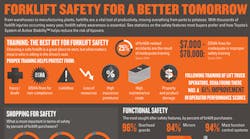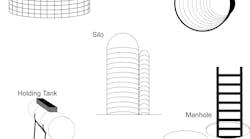We ran an article recently about the prospect of using video games to attract young talent to come and work in warehousing and distribution. Rich Sherman, supply chain expert with Trissential, a management consultancy, asked, “What if instead of playing ‘Call of Duty,’ my labor force played ‘Called to the Warehouse?’ What if instead of navigating through buildings and hallways in the game, they navigated remotely through the warehouse and aisles?”
When we published that I had no idea how close Rich was to the real world. Turns out, a Cummins engine plant in Jamestown, NY is using a virtual reality training program for forklift operators. The program’s developer, Tactus Technologies, hopes its product will reduce work-related injuries and deaths associated with forklift operation.
This “3D Forklift Trainer” enables operators to practice on a video game-like system featuring a steering wheel, joystick, pedals and simulated environments such as warehouses, elevators and railroad tracks. The company saw a market need in the stats put out by the Occupational Safety and Health and Administration (OSHA): 100 fatalities and more than 100,000 injuries annually associated with lift truck operation in the United States.
This is quite a change from the usual methods of lift truck operator training, which combines class time with videos and on-the-job supervision. The simulator was created with a grant from the National Institutes of Occupational Safety and Health (NIOSH) and incorporates safety lessons aligned with OSHA standards.
Users get a full license for the 3D Forklift Trainer software, a customized computer, as well as a steering wheel and pedals. And you man-cave dwellers will love this: a 60-inch screen and specialized forklift-type seating are options.
Is this what it will take to chop a significant chunk out of those fatality and injury stats? The lift truck OEMs have certainly done their part in balancing the innovation of their safety features with the cost sensitivity of their customers. Nevertheless, those OSHA stats seem to stay relatively constant. Maybe licensing 3D gaming technology is what it will take to change operators’ careless ways.
David Hoover, an instructor with Forklift Training Systems in Newark, OH, thinks another kind of licensing might also be effective. He told me lift truck OEMs should be licensing the safety technology automotive manufacturers developed to make our nation’s roads safer. He doesn’t believe safety should be a proprietary selling feature.
“The car companies were forced to upgrade safety in the 70s,” he said. “You didn't see GM saying, ‘we have safety glass but the others don’t,’ they all did it.”
One example of proprietary lift truck safety technology everyone can applaud is Toyota’s System of Active Stability, which corrects for unstable operating conditions. This has actually paid off for many companies from a safety perspective. That’s the kind of technology that OEMs and end users should be licensing, Hoover believes, in addition to things like automatic braking and blindspot monitoring, which are now becoming common in the automotive world. Sure, this would be costly for lift truck OEMs to develop themselves, he says, but…
“If they could just license the technology from a company that already developed it, it would not be nearly as costly.”
There’s always been an industry chasm between forklifts and cars. Perhaps safety could be the bridge.
Then again, maybe making forklifts feel too much like cars would give operators a false sense of security, leading them to take risks they otherwise would be scared to try. It’s like Dad always said, “A little fear never hurt anyone.”




